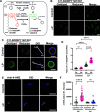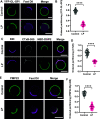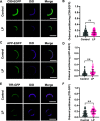Lipid Peroxidation Drives Liquid-Liquid Phase Separation and Disrupts Raft Protein Partitioning in Biological Membranes
- PMID: 38171000
- PMCID: PMC10797634
- DOI: 10.1021/jacs.3c10132
Lipid Peroxidation Drives Liquid-Liquid Phase Separation and Disrupts Raft Protein Partitioning in Biological Membranes
Abstract
The peroxidation of membrane lipids by free radicals contributes to aging, numerous diseases, and ferroptosis, an iron-dependent form of cell death. Peroxidation changes the structure and physicochemical properties of lipids, leading to bilayer thinning, altered fluidity, and increased permeability of membranes in model systems. Whether and how lipid peroxidation impacts the lateral organization of proteins and lipids in biological membranes, however, remains poorly understood. Here, we employ cell-derived giant plasma membrane vesicles (GPMVs) as a model to investigate the impact of lipid peroxidation on ordered membrane domains, often termed membrane rafts. We show that lipid peroxidation induced by the Fenton reaction dramatically enhances the phase separation propensity of GPMVs into coexisting liquid-ordered (Lo) and liquid-disordered (Ld) domains and increases the relative abundance of the disordered phase. Peroxidation also leads to preferential accumulation of peroxidized lipids and 4-hydroxynonenal (4-HNE) adducts in the disordered phase, decreased lipid packing in both Lo and Ld domains, and translocation of multiple classes of raft proteins out of ordered domains. These findings indicate that the peroxidation of plasma membrane lipids disturbs many aspects of membrane rafts, including their stability, abundance, packing, and protein and lipid composition. We propose that these disruptions contribute to the pathological consequences of lipid peroxidation during aging and disease and thus serve as potential targets for therapeutic intervention.
Conflict of interest statement
The authors declare no competing financial interest.
Figures






Update of
-
Lipid peroxidation drives liquid-liquid phase separation and disrupts raft protein partitioning in biological membranes.bioRxiv [Preprint]. 2023 Sep 14:2023.09.12.557355. doi: 10.1101/2023.09.12.557355. bioRxiv. 2023. Update in: J Am Chem Soc. 2024 Jan 17;146(2):1374-1387. doi: 10.1021/jacs.3c10132. PMID: 37745342 Free PMC article. Updated. Preprint.
References
Publication types
MeSH terms
Substances
Grants and funding
LinkOut - more resources
Full Text Sources
Research Materials

